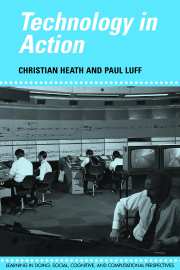Book contents
- Frontmatter
- Contents
- Preface
- 1 Technology and social action
- 2 Documents and professional practice: ‘bad’ organisational reasons for ‘good’ clinical records
- 3 Animating texts: the collaborative production of news stories
- 4 Team work: collaboration and control in London Underground line control rooms
- 5 The collaborative production of computer commands
- 6 ‘Interaction’ with computers in architecture
- 7 Reconfiguring the work space: media space and collaborative work
- 8 Organisational interaction and technological design
- References
- Index
6 - ‘Interaction’ with computers in architecture
Published online by Cambridge University Press: 22 September 2009
- Frontmatter
- Contents
- Preface
- 1 Technology and social action
- 2 Documents and professional practice: ‘bad’ organisational reasons for ‘good’ clinical records
- 3 Animating texts: the collaborative production of news stories
- 4 Team work: collaboration and control in London Underground line control rooms
- 5 The collaborative production of computer commands
- 6 ‘Interaction’ with computers in architecture
- 7 Reconfiguring the work space: media space and collaborative work
- 8 Organisational interaction and technological design
- References
- Index
Summary
Let him be educated, skilful with the pencil, instructed in geometry, know much history, have followed the philosophers with attention, understand music, have some knowledge of medicine, know the opinions of the jurists, and be acquainted with astronomy and the theory of the heavens.
Vitruvius (1960: 5–6, cited in Cuff, 1992: 84)Introduction
One of the most noticeable developments in personal computers in recent years has been the widespread deployment and use of graphical user interfaces. Rather than typing commands and instructions, users are presented with a range of devices, such as windows, icons, menus and cursors, through which they operate the system. Particular activities on the computer, like word processing, organising electronic files, navigating around the system and switching tasks have been considerably transformed by the introduction of interfaces on which graphical objects are displayed and are manipulated around the screen. Although graphical interfaces appear to be easier to use, it is not clear what the reasons for this might be. Hence, these systems have been a focus of interest for researchers in HCI; research which has sought to explain the ways different kinds of interfaces are used in terms of the cognitive capabilities of the user and the semantic qualities of the system (e.g. Ankrah et al., 1990; Hutchins et al., 1986; Norman and Draper, 1986; Schneiderman, 1992). Of particular concern has been to develop an analysis of an individual's direct interaction with, or manipulation of, the system and how screen objects are perceived and understood.
- Type
- Chapter
- Information
- Technology in Action , pp. 155 - 178Publisher: Cambridge University PressPrint publication year: 2000

